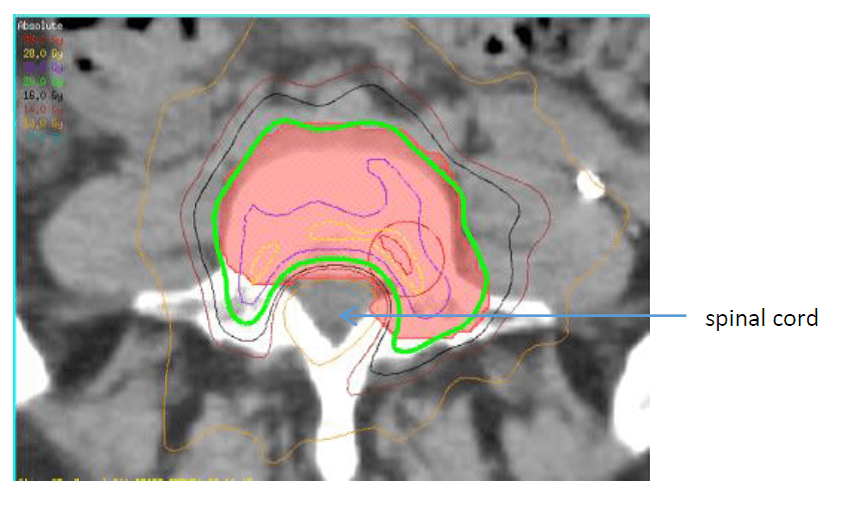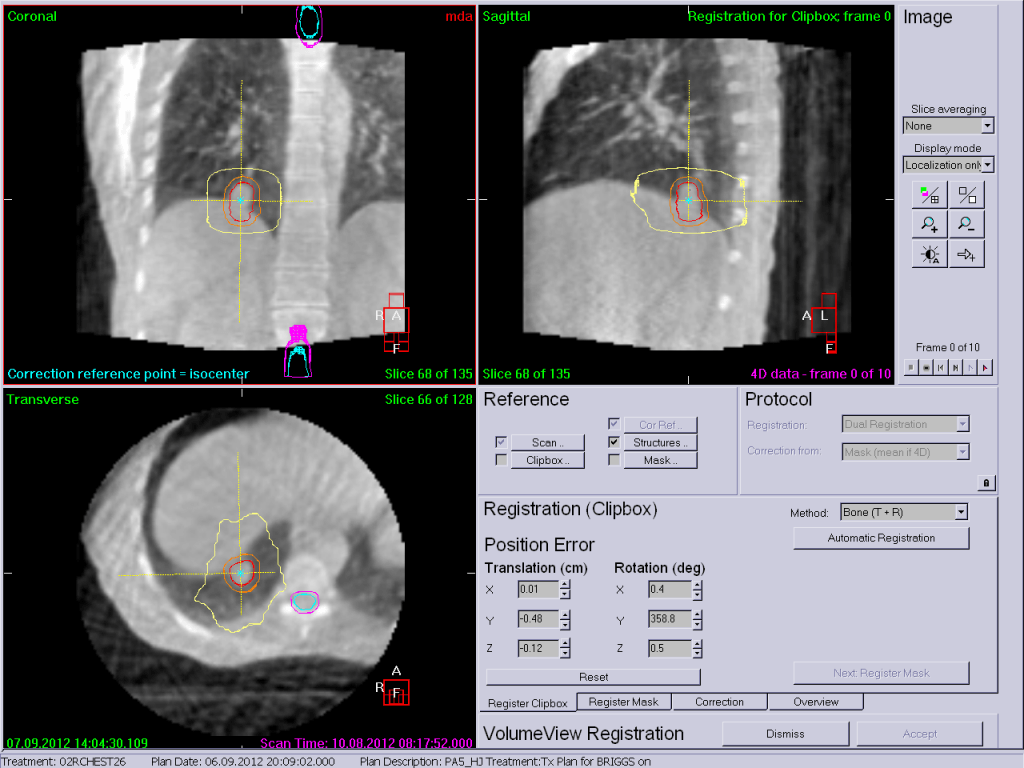Stereotactic Body Radiation Therapy (SBRT)

Stereotactic body radiation therapy or radiotherapy (SBRT) and stereotactic ablative radiation therapy or radiotherapy (SABR) both describe an advanced form of radiation therapy that is used to treat many different types of cancer. The two terms are interchangeable. It is used to treat both primary cancer (where the cancer started such as the lung or the prostate), or where a cancer may have spread (secondary cancers or metastases). Secondary cancers treated with SBRT include those in the bone, lung or liver.
This technique differs from other external beam radiation therapy as it involves the delivery of higher doses of radiation to the cancer. This is why the word ‘ablative’ is part of the name sometimes given for this type of treatment. These higher doses are given to the patient from Xray beams directed from outside the body ( see external beam radiation therapy) and using a small number of treatments (also called fractions). Typically, one to five treatments are used over a few days. The delivery technique is extremely precise which is what the term ‘stereotactic’ refers to. There are several technologies available in Australia that can be used to deliver this technique including Linac based, Cyberknife, Tomotherapy and Gammaknife.
The ability to deliver SBRT has been made possible by several technological advances including keeping patients comfortably very still during treatment, tracking the movement of the tumour, better tumour identification and more precise and accurate delivery of the radiation therapy (see IGRT). As this type of treatment requires millimetre accuracy, it also requires significantly improved methods to ensure that the radiation is focused on a small area of cancer within the patient. This means that patient-specific or customised immobilisation devices are usually required to be made as part of preparing for treatment. Immobilisation devices are pieces of equipment that make sure the patient cannot move the body part being targeted during radiation therapy. These include head and neck ‘masks’ and evacuated vacuum cushions or cradles.
With modern radiation therapy, it is now possible to take a scan at the time of treatment using a mini CT scanner to ensure accuracy of the treatment delivery. When the radiation therapy is given to the target (tumour or cancer), the dose is high at this spot but falls off rapidly outside the target. This means there is a low risk of damaging adjacent normal healthy tissues or organs. Often limiting or adjusting for movement of the cancer (for instance in the lung as the patient breathes) is done to make sure the cancer is not missed and the surrounding tissue (in this case the lung) does not get too much radiation.
In many situations where SBRT is recommended or is now considered to be a treatment option, this is as an alternative to surgery for removal of small to moderately sized cancers. This avoids the need for an anaesthetic and the risks of an operation, especially for patients who are elderly, frail or have other health issues that might make surgery risky or impossible. At some cancer sites e.g. bone, an operation is not feasible or may be extremely difficult. This is why sometimes SBRT is called a ‘minimally invasive’ cancer treatment technique. This special type of radiation therapy is becoming more prevalent and available as the evidence for its use continues to grow.
Specific examples of SBRT/SABR
Specific examples of SBRT/SABR include:
Lung SBRT/SABR is a established treatment option for early stage non-small cell lung cancer and patients with one or a few lung metastasis (secondaries). It is understood that very high radiation doses are required to control non-small cell lung cancer. The doses with this technique are much higher than achieved with conventional radiation therapy techniques in the past. Lung SBRT was initially used for peripheral lung tumours (towards the lung edges) however is being used for more central tumours (tumours towards the middle of the lungs and deeper in the lungs). The movement of patient breathing can be adjusted for meaning that very high and focused radiation doses can be given. In several clinical trials, the chance of controlling the cancer in the lung with this technique is up to 98% better than using older techniques. Lung SBRT may also be a treatment option for patients with small amount of metastatic lung disease (secondary tumours from other cancers that have spread to the lung).
Bone/Spine SBRT/SABR is largely used for metastatic disease (secondary cancers) in the spine. The aim is to improve symptoms, such as pain, and quality of life by controlling the cancer in the spine over the longer term. SBRT to the spine and other bones provides better control of the tumour in that bone and also allows re-treatment to occur (where a patient may have had previous more conventional radiation therapy). As the spinal cord is often right next to the area being treated, very strict and accurate delivery measures are used (see above re immobilisation and imaging) to ensure that this treatment remains safe.
Liver SBRT/SABR: There is developing experience with the use of SBRT for the treatment of cancer in the liver. This is for both primary liver cancers such as hepatocellular carcinoma and for secondary cancer (metastases) in the liver. The latter is much more common as many cancers spread to the liver. The results for both primary and metastatic liver disease using SBRT are that local control of the cancer is often excellent and occasionally, patients treated with this technique may be long-term survivors. By choosing patients who are most suitable for this treatment type, and by sparing of the healthier parts of the liver, serious side effects can be avoided.
Prostate SBRT/SABR: Experience is being gained in treating localised prostate cancer with SABR usually with 5-7 treatments as well with promising control of prostate cancer. This is an option as an alternative to surgery and conventional radiation therapy options, although it must be emphasised this is a more recent innovation.
Other Sites: Although most SBRT experience is in lung, spine and liver there are a number of other sites where it can be used. SBRT to soft tissue secondary (metastatic) deposits may be used as an alternative to other local treatments like surgery, or to more conventional doses of radiation therapy. SBRT has also been used in the treatment of primary renal (kidney) cancers in patients that cannot have surgery and also for secondary deposits in adrenal tumours with early success.

An MRI image shows a radiation therapy plan for treatment of a metastasis (secondary cancer) in a vertebra (spine bone). The high radiation dose shown by the green line surrounds the cancerous bone to be treated, shown in shaded red. The spinal cord, which is sensitive to radiation, is spared from getting too much radiation as the high dose is made to wrap around it.




